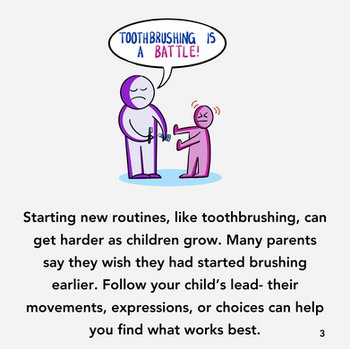
When to brush
Overview
Brushing your child’s teeth is an important part of their daily routine to ensure good oral health. Ideally, you should brush their teeth twice a day: once before bed and once at another convenient time during the day. This guide provides practical tips and advice from other parents on how to make toothbrushing a smoother experience, whether it’s incorporating it into the bedtime routine or finding a suitable time during the day.
About our "One step at a time" boxes
We know that some days can be really hard, and making small changes one step at a time can help with brushing, eating and drinking and going to the dentist. That’s why we’ve made special “One step at a time” boxes throughout the webite. These give you small tips to try, step by step. They’re just a starting point for tough days, and the idea is to build up from there. Think of these boxes as friendly reminders to make things manageable. It’s all about taking small steps and being kind to yourself. Hear from Nikki about this.

Toothbrushing last thing at night
Parents who helped us develop toothPASTE told us: “Last thing at night can be a major challenge for so many of us parents because it can heighten and distress the child” Some parents find it easier to brush when the child is still sleepy or when they are in the bath as part of their nighttime routine. Other children may find toothbrushing is overstimulating at bedtime and could stop them from going to sleep. Last thing at night does not necessarily mean that toothbrushing needs to be the last thing done before going to sleep. It means not having anything to eat or drink after brushing the teeth before going to bed. It may be preferable to brush a little while after the evening meal and then try (if possible) to make sure that only water is drunk after this point.
One step at a time: building towards reducing food and drink before bed
We are aware that avoiding food or drink before bed may be difficult especially if children are on Melatonin which might need to be hidden in a food like yoghurt or custard and taken 30-60 minutes before bedtime. If brushing the teeth after this is not possible after eating, use a clean, damp flannel or towel, with fluoride toothpaste to wipe their teeth. Just be aware that these might shed fluff, which your child might not like. Other options include using a clean baby muslin or microfibre towel. Adding toothpaste to one of these can help introduce fluoride into your child’s mouth and protect their teeth.
Please note, your child might get attached to using the flannel, towel or alternative brush, which could make it hard to switch to a traditional toothbrush later. We recommend reading 'Tips to introduce toothbrushes' for ideas to help during this process.
Remember, this is a goal towards building a full toothbrushing routine, taking it one step at a time. Hear from Nikki about this.

Toothbrushing one other time of day
While it is ideal to brush before breakfast, we know that some parents find it helpful to brush just before their child leaves for school or nursery. This is often downstairs, whilst their child is sitting in the chair after their breakfast. If this works for your family, you could keep another brush and toothpaste downstairs. If your child is able, you can ask them to spit out into a cup or tissue or open their mouth wide. If you feel this may work for your family, you may find this checklist helpful for some considerations and adaptions.
If this causes disruption, you could try brushing after a calming activity or during a less rushed time of day. You may find making brushing fun useful as a starting point.
Key messages

Watch again
Jump straight to what parents and early years professionals have said about when to brush.




